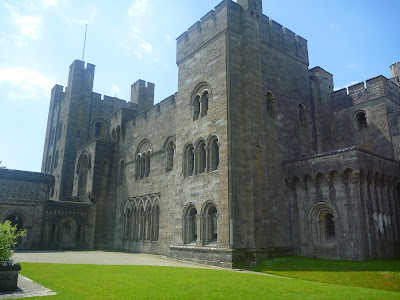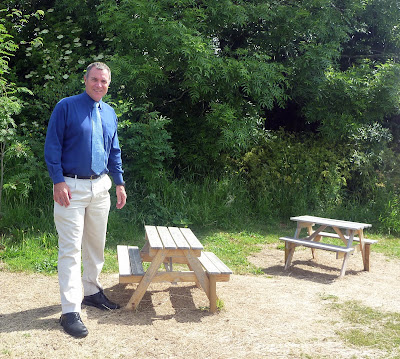Wednesday, June 30, 2010
Shannaghmore Outdoor Education Centre
Posted by Stuart Cumming at 5:22 PM 4 comments
Labels: Forest School
Tuesday, June 29, 2010
Hazelwood Integrated Primary School (Belfast Northern Ireland)
Posted by Stuart Cumming at 6:59 AM 4 comments
Labels: Forest School
Sunday, June 27, 2010
Giants' Causeway and photos of Ireland and Northern Ireland




Giant's Causeway...County Antrim...Northern Ireland
Posted by Stuart Cumming at 5:33 AM 0 comments
Ireland/Northern Ireland
Northern Ireland and Ireland in 2 days!
Hi all, this is Mrs Cumming. We are up the north west of Ireland in County Donegal. It is 10pm and Mr Cumming has gone off to find a mountain to climb! It is still light here so we are able to make the most of every day...working during the day for Mr Cumming and then exploring in the afternoon/evening. I read that it has been really cold in Bunbury..we have been very lucky over here, with hardly any rain.
We arrived in Ireland last week and had a few days off visiting Ireland's west coast.There are castles, ruins, cliffs, mountains, green hills, lakes everywhere and it is all so beautiful. We then drove across to Northern Ireland, near Belfast, where Mr Cumming visited the school (see last post), then that afternoon we headed up the coast to see the most stunning scenery....my favourite was a place called the Giant's Causeway (see photos) which is a large mass of column rocks formed over 60 million years ago by volcanic activity.The tops of the columns form stepping stones that lead from the cliff foot and disappear under the sea. Most of the columns are hexagonal although there are also some with four, five, seven and eight sides. The tallest are about 12 metres (36 ft) high and they all fit together like a jigsaw. There are about 40 000 rocks in the area, but I'm not sure who counted them! Ask Mr Cumming the other story of how they were formed which I think is a much better story..about the 2 giants!
We then drove along the coast but it took us 7 hrs to travel 160 kms because we kept stopping to look at all the amazing scenery. This morning we found a very old castle called Dunluce Castle which was built in the 16th Century. It is perched high on a cliff and has started to fall down, but is great to see and read about. (see photos)
We then caught a car ferry to Ireland where we drove to the most northern point of Ireland..a place called Malin Head. Again the scenery was beautiful and we decided to take the car on a gravel track and walked about 1km to a magnificent set of cliffs. Ther are very high and sheer, which means they drop straight down into the ocean. It is really scary walking along the edge of them, but the views were breathtaking. I will put some photos up and if you look really carefully you may see Mr Cumming at the top of one and me at the top of another.
Tomorrow we will explore a tiny bit more of Ireland before driving back to Northern Ireland. Mr Cumming is meeting with 3 different people on Monday in Belfast and then we drive to Dublin (Ireland's capital) to fly back to England where Mr Cumming has a conference as well as a school visit. On Friday we have to be in Wales to visit another school! PHEW! So 4 countries in 1 week!
I know this is your last week of school, so have a safe holiday and we will see you all next term..
Seeya, Mrs Cumming
Posted by Stuart Cumming at 5:18 AM 1 comments
Saturday, June 26, 2010
Fairview Primary School (Belfast Northern Ireland)
Today I visited Neil McAllister from
FairviewPrimary is currently involved in a number of programs I have already looked at to varying degrees:
I was particularly interested in what the school did in relation to its
I had the opportunity to speak to Neil’s class about Forest Schools and they were so positive. One common thread across the three P6 classes who undertook the program was when returning to class, students were required to keep a detailed diary. Art, Health, Mathematics, Literacy, Science activities were all explained in detail by students. They obviously had retained much of the information covered in
Link to more pictures.
Posted by Stuart Cumming at 3:00 PM 3 comments
Labels: School Visits
Friday, June 25, 2010
Bonfire Night
Posted by Stuart Cumming at 2:43 PM 2 comments
Labels: Places of Interest
Wednesday, June 23, 2010
Ireland
 Ireland Pictures
Ireland PicturesI'm now in Ireland heading to Northen Ireland where I will be visiting schools and also the Belfast Activity Centre .
Posted by Stuart Cumming at 4:07 PM 4 comments
Tuesday, June 22, 2010
Forest School Wales
More Forest School Pictures
Here the
The driving force behind Lisa’s position as a
Small groups of students,(approximately 1/3 of the class), undertake either a morning or afternoon in the
I was really interested in how the program operated, and why it was so successful. I had seen many similar facilities however their utilisation of these through the Forest School Program was different to the more formalised approach undertaken in Outdoor Classrooms. In a similar vein to the Nature Kindergarten, activities were directed but if children chose to go in another direction to the planned lesson, this was fine, even encouraged. What was great in this instance was I was able to observe the class practice. Charlotte T, the Teacher Assistance who ran the program, together with Charlotte the Special Needs assistant were generous enough to let me sit in on their morning session and observe their interaction with nine 5 year old students.
Initially they went through a meet and greet routine where they virtually revised previous practice; this was followed with some discovery sessions on “Fairy” posts that had been left behind. A sharing session where children went and collected interesting objects was followed by an introduction and practical session with wood working tools, utilising natural materials from the school woodland. What was really interesting was that as Charlotte A went through the sessions the children guided and paced the session. If something else took their fancy then that was fine. One student spent a lot of time under a tarpaulin, another crawling through the grass, other students explored mole diggings. All this was fine and assisted in pacing the lesson to individual needs. There seemed to be a great deal of flexibility built into the program. The children also went through a process where they were learning the safety aspects of having a fire as they have a special area to light fires. This was in preparation for doing some cooking in a few weeks.
Posted by Stuart Cumming at 3:24 AM 4 comments
Labels: Forest School
Thursday, June 17, 2010
Slate Mine & Portmeirion
Today the camp followed the historical theme with a visit to an underground slate mine, where we caught a train underground and were able to, for a short time, imagine what life had been like for a 12 year old boy who spent his entire life working in the mines….this was a guided tour and really interesting as a follow on of the slate theme of the past few days. We then visited the resort
The students all did some sketching of the buildings then headed off on a walk through a lush, green forest, followed by a swim at the beach, Today’s summer weather was similar to a sunny winter’s day in Bunbury and even I went for a swim!
As today was the last day of camp we were invited to a BBQ by the lake near the hostel and I was able to teach the kids a rendition of Aussie Aussie Aussie to chant while they were supporting
It was fantastic to spend time with Charles, Andrew, Jason, Pam and Dorinda…a dedicated staff that the children are obviously very comfortable with. Their commitment was strongly evident and there was mutual respect amongst all staff and students. A fantastic experience and a terrific week with the staff and Yr 6 students of
Posted by Stuart Cumming at 2:20 PM 0 comments
Labels: Places of Interest
Wednesday, June 16, 2010
Conwy Castle
Tuesday 16 June
Today we went for another long walk with the students from Moulsecoomb Primary who are on camp here in
Children collected samples from the woods throughout the walk which really focused their observations. Collected items will be used for art work on their return to

Posted by Stuart Cumming at 6:06 AM 0 comments
Labels: Moulsecoomb Primary School
Tuesday, June 15, 2010
Penrhyn Castle
Today the camp followed up on yesterday’s visit to the slate mine with a look at the other side of the equation. The owner of the mine built
Victorian games and toys were so basic; much was left up to children’s imagination. It reminded me of much of what was said at the Mindstretchers Conference. The Victorians had to use their imagination and improvisation really added another element to learning through play which is not prevalent in today’s games. Interestingly many of the children commented on how they would prefer these games to the ones they played now. Perhaps they were just in the moment.
The day ended with a tour of the castle, followed by an hour session in a large forested adventure playground. The enthusiasm of the staff on camp is fantastic and having a teacher run a tour of a stately home as opposed to a tour guide was brilliant. He was able to put everything at the children’s level and the questions posed to them by Andrew (their teacher) made all they were seeing so relevant. A great day...even though I was teased mercilessly by the students for


Posted by Stuart Cumming at 4:54 AM 5 comments
Labels: School Visits
Snowdon View (In Song) Head Teacher & Yr 6 Teacher
Posted by Stuart Cumming at 1:32 AM 2 comments
Labels: Moulsecoomb Primary School
Monday, June 14, 2010
Snowdonia National Park
Posted by Stuart Cumming at 3:34 PM 3 comments
Labels: School Visits
Sunday, June 13, 2010
Moulsecoomb Primary School (Wales Camp)
Posted by Stuart Cumming at 7:10 AM 5 comments
Labels: School Visits








































